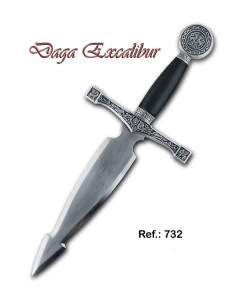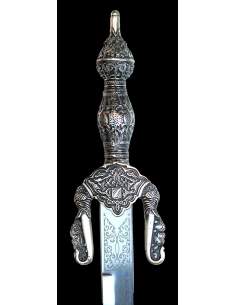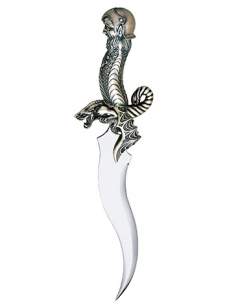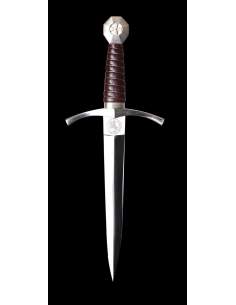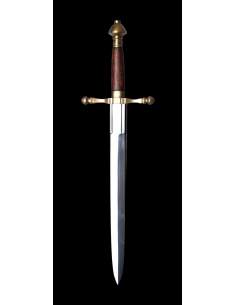Free shipping throughout Spain. International shipments to the whole world.
PERSONALIZED attention every day from 09:00 to 21:00
Daggers
Medieval Ancient Daggers
A dagger, according to its definition, is a bladed weapon, which is characterized by having a short blade, normally around 30 cm in length, with a garnish to protect the fist and hawks for the handles. Ancient daggers usually had two edges, although one-, three-, and even four-edge versions are also known. A dagger should not be confused with a dagger, since the dagger is shorter.
The dagger was usually used as a secondary weapon, which complemented the sword, although it was also used for hand-to-hand attacks or in case of emergency. Daggers, due to their convenient size, were also used by women for protection.
We know that the first ancient daggers were made in the Bronze Age, that is, more than 5000 years ago. At first they were not made of metal but of bone, flint or ivory. The greatest development of daggers and the creation of a multitude of varieties took place during the Middle Ages, at the end of the 13th century.
Types of daggers
Because the dagger was a weapon used by almost all cultures, there are a large number of types of ancient daggers. Of all the types of daggers, the best known and used throughout history are the following:
· Roman daggers: also called pugio, it is a small dagger that was used by the ancient Romans. It usually had a blade between 18 and 28 cm in length and about 5 cm in width. The handle of these ancient daggers was narrow and measured about 12 cm, it was made of horn or wood and had an anatomical shape, which made it easier to handle in combat. It was a perfect weapon for stabbing.
· Medieval daggers: at this time you could find medieval daggers with straight, curved and even zigzag-shaped blades. They normally used to have a leaf length of about 30-40 cm. The handle of this type of weapon did not have any guard to protect the hand. Medieval daggers could be highly decorated or have almost no aesthetic details. It all depended on its use. That is, the most elaborate daggers, which were used to complement the costume, came to have precious stones in their design, while the daggers made for battle lacked decorations of any kind.
· Eared dagger: so called because of the curious shape of the handle, which was topped by discs that formed the pommel. These ancient daggers were normally made of bone or ivory and their double-edged blade usually had a length of 20-30 cm. The origin of this dagger is found in the Kingdom of Granada, in the 15th century.
· Cinquedea Dagger: it is a weapon that comes from 15th century Italy, it is one of the last medieval daggers manufactured at this time. Its name means five fingers, since it had a handle that was five fingers wide. It is also known as Oxtongue, which is sometimes called a “short sword”, because it had a blade length of about 55 cm, which for a dagger was quite excessive. It was used mainly by the civilian population as a defense weapon.
· Dirk: which is also known as a Scottish dagger, appears in the 17th century and is distinguished from others by its greater length, bringing it closer to a sword. In fact, quite often this type of dagger had a sword blade instead of a knife blade. They were single-edged daggers, and stood out for their striking and varied decoration. Its handle was made of briar wood.
· Gumía or Arab dagger: with its typical curved blade, it normally measured about 30-40 cm. It was mainly used by Arab peoples. The particular thing about this type of dagger is not only the shape of its blade, but also its spectacular decoration, created with so much mastery and so many details, that it still continues to surprise us.
· Stiletto: it is a dagger with a pointed, robust and very narrow blade, designed to be able to penetrate chain mail, as well as to penetrate between the metal plates of the armor of a medieval knight. It was used not only as a defensive weapon, but also to kill wounded and fallen enemies, for which it received a second name, “merciful.” The length of a stylet blade varied greatly, ranging from 20 to 40 cm.
In this category we offer you a careful selection of ancient daggers from different cultures and different periods, some of them well recognized as medieval daggers, made with the best materials. These are very precise replicas of daggers from times past. So, if you're planning to participate in a historical reenactment, for example, you'll especially love this section.




